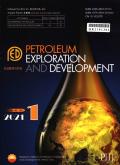Impact of clay coating on sandstone reservoir quality: A multiphase-field investigation by numerical simulation
IF 8
Q1 ENERGY & FUELS
引用次数: 0
Abstract
The presence of clay coatings on the surfaces of quartz grains can play a pivotal role in determining the porosity and permeability of sandstone reservoirs, thus directly impacting their reservoir quality. This study employs a multiphase-field model of syntaxial quartz cementation to explore the effects of clay coatings on quartz cement volumes, porosity, permeability, and their interrelations in sandstone formations. To generate various patterns of clay coatings on quartz grains within three-dimensional (3D) digital sandstone grain packs, a pre-processing toolchain is developed. Through numerical simulation experiments involving syntaxial overgrowth cementation on both single crystals and multigrain packs, the main coating parameters controlling quartz cement volume are elucidated. Such parameters include the growth of exposed pyramidal faces, lateral encasement, coating coverage, and coating pattern, etc. The coating pattern has a remarkable impact on cementation, with the layered coatings corresponding to fast cement growth rates. The coating coverage is positively correlated with the porosity and permeability of sandstone. The cement growth rate of quartz crystals is the lowest in the vertical orientation, and in the middle to late stages of evolution, it is faster in the diagonal orientation than in the horizontal orientation. Through comparing the simulated results of dynamic evolution process with the actual features, it is found that the simulated coating patterns after 20 d and 40 d show clear similarities with natural samples, proving the validity of the proposed three-dimensional numerical modeling of coatings. The methodology and findings presented contribute to improved reservoir characterization and predictive modeling of sandstone formations.
粘土包覆层对砂岩储层质量影响的多相场数值模拟研究
石英颗粒表面是否存在粘土包覆层,是决定砂岩储层孔隙度和渗透率的关键因素,直接影响储层质量。本研究采用合成石英胶结的多相场模型来探索粘土包覆层对砂岩地层中石英胶结体积、孔隙度、渗透率及其相互关系的影响。为了在三维(3D)数字砂岩颗粒包中生成石英颗粒上的各种粘土涂层图案,开发了一个预处理工具链。通过对单晶和多晶复合胶结的数值模拟实验,阐明了控制石英胶结体积的主要涂层参数。这些参数包括外露锥体面的生长、侧向包裹、涂层覆盖范围和涂层模式等。涂层模式对胶结有显著的影响,层状涂层对应于快速的水泥生长速率。涂层覆盖度与砂岩孔隙度、渗透率呈正相关。石英晶体的胶结生长速率在垂直方向上最低,在演化的中后期,在对角线方向上比在水平方向上更快。通过将动态演化过程的模拟结果与实际特征进行对比,发现20 d和40 d后的模拟涂层图案与自然样品具有明显的相似性,证明了所提出的涂层三维数值模拟的有效性。所提出的方法和发现有助于改进储层表征和砂岩地层的预测建模。
本文章由计算机程序翻译,如有差异,请以英文原文为准。
求助全文
约1分钟内获得全文
求助全文

 求助内容:
求助内容: 应助结果提醒方式:
应助结果提醒方式:


